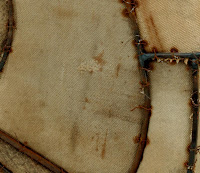At the Pompidou, I'm working on my second article.
My first was on Lee Bontecou, and this one is on Magdalena Abakanowicz. Both were chosen almost at random, because I simply don't know enough modern/contemporary art history to know really what I like, who I like, who I want to learn about. These two artists were picked because, from a sample size of one or two works, I found them interesting.
They are both scuptors. They also share a lot. It was while starting on the Abakanozicz piece that I realized how similar they were in many superficial ways - color choice, for instance - that may or may not reveal something about my taste, but also in two very important areas, theoretically speaking.
When we think of highly formalist art, we think of art that is sterile - either the oh-so-carefully rule-bound compositions of academicism, or the constructivist dream of art devoid of culturally contingent connotations - an attractive vision to be sure, but one which is doomed to end up totally devoid of meaning, if it could ever succeed. Yet art that is not formalist in some sense cannot be good art.

What do I mean by formalist, then? I mean art that sincerely engages with and reveals its form, its medium. Art that does not try to make a whole, a self-sufficient statement, or to conceal the secret of its making, but admits its materiality. This can express itself in different ways.
Lee Bontecou's early work consists of welded structures to which she tied canvas with wire, and include at least one black hole. See the image at left (Untitled, 1959, welded steel, canvas, black fabric, and wire, 147.5 x 148.5 x 44 cm, MoMA.) The work engages its materiality in many ways.
The roughness of the steel, the wire stitching, show you how the work was made. It shows you the physicality of the frame and the canvas which are usually hidden in a painting - the work comes out of its materials rather than being imposed upon them. It reminds you of what canvas is, how it is a thick, rough fabric with that we use in our daily lives, in our clothing, our tents, our machines. It reminds us that the canvas fades and decays.

At the same time, the work challenges us to rethink illusionism. Because it has real relief, because the black hole really is a hole, it reminds us that painting is flat, even if it seems to go beyond itself into three dimensions. It uses the rules of proportion in what could be an illusionistic manner but it is actually physically extant. Yet it also exaggerates its relief, challenging our conceptions of sculpture as a superficial object in space.
So her work, existing between both painting and sculpture, challenges the formal conventions of both in a way that subverts our expectations and embraces, to transcend, its limitations as an art object.
Abakanowicz does something similar in her very process-dependent sculpture, which revels in the accidents of its making and degradation, either made of organic material or successfully transforming an inorganic material like bronze into a living thing.